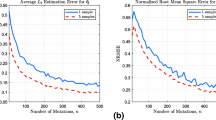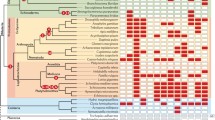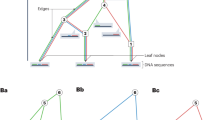Abstract
Various population genetic models of duplicated genes are introduced. The problems covered in this review include the fixation process of a duplicated copy, copy number polymorphism, the fates of duplicated genes and single nucleotide polymorphism in duplicated genes. Because of increasing evidence for concerted evolution by gene conversion, this review introduces recently developed gene conversion models. In the first half, models assuming independent evolution of duplicated genes are introduced, and then the effect of gene conversion is considered in the second half.














Similar content being viewed by others
References
Arguello JR, Chen Y, Yang S, Wang W, Long M (2006) Origination of an X-linked testes chimeric gene by illegitimate recombination in Drosophila. PLoS Genet 2:e77
Arnheim N (1983) Concerted evolution of multigene families. In: Nei M, Koehn RK (eds) Evolution of genes and proteins. Sinauer, Sunderland, pp 38–61
Avent ND, Reid ME (2000) The Rh blood group system: a review. Blood 95:375–387
Bailey GS, Poulter RTM, Stockwell PA (1978) Gene duplication in tetraploid fish: model for gene silencing at unlinked duplicated loci. Proc Natl Acad Sci USA 75:5575–5579
Bailey JA, Gu Z, Clark RA, Reinert K, Samonte RV, Schwartz S, Adams MD, Meyers EW, Li PW, Eichler EE (2002) Recent segmental duplications in the human genome. Science 297:1003–1007
Baltimore D (1981) Gene conversion: some implications for immunoglobulin genes. Cell 24:592–594
Blanc G, Wolf KH (2005) Widespread paleopolyploidy in model plant species inferred from age distributions of duplicated genes. Curr Opin Plant Biol 8:135–141
Brown DD, Wensink PC, Jordan E (1972) A comparison of the ribosomal DNA’s of Xenopus laevis and Xenopus mulleri: the evolution of tandem genes. J Mol Biol 63:57–73
Charlesworth D, Mable BK, Schierup MH, Bartolomé C, Awadalla P (2003) Diversity and linkage of genes in the self-incompatibility gene family in Arabidopsis lyrata. Genetics 164(4):1519–1535
Clark AG (1994) Invasion and maintenance of a gene duplication. Proc Natl Acad Sci USA 91:2950–2954
Crow JF, Kimura M (1970) An introduction to population genetics theory. Harper & Row, New York
Dover G (1982) Molecular drive: a cohesive mode of species evolution. Nature 299:111–117
Drouin G (2002) Characterization of the gene conversions between the multigene family members of the yeast genome. J Mol Evol 55:14–23
Elder Jr JF, Turner BJ (1995) Concerted evolution of repetitive DNA sequences in eukaryotes. Q Rev Biol 70:297–320
Emerson JJ, Cardoso-Moreira M, Borevitz JO, Long M (2008) Natural selection shapes genome-wide patterns of copy-number polymorphism in Drosophila melanogaster. Science 320:1629–1631
Ewens WJ (2004) Mathematical population genetics. I. Theoretical introduction. Springer-Verlag, New York
Ezawa K, Oota S, Saitou N (2006) Genome-wide search of gene conversions in duplicated genes of mouse and rat. Mol Biol Evol 23:927–940
Fisher RA (1930) The genetical theory of natural selection. Oxford University Press, Oxford
Fisher RA (1935) The sheltering of lethals. Am Nat 69:446–455
Force A, Lynch M, Pickett FB, Amores A, Yan Y-I, Postlethwait J (1999) Preservation of duplicate genes by complementary, degenerative mutations. Genetics 151:1531–1545
Fu Y-X, Li W-H (1993) Statistical tests of neutrality of mutations. Genetics 133:693–709
Fu Y-X, Li W-H (1999) Coalescing into the 21st century: an overview and prospects of coalescent theory. Theor Popul Biol 56:1–10
Gangloff S, Zou H, Rothstein R (1996) Gene conversion plays the major role in controlling the stability of large tandem repeats in yeast. EMBO J 15:1715–1725
Gao L-Z, Innan H (2004) Very low gene duplication rate in the yeast genome. Science 306:1367–1370
Goldman AS, Lichten M (1996) The efficiency of meiotic recombination between dispersed sequences in Saccharomyces cerevisiae depends upon their chromosomal location. Genetics 144:43–55
Gu Z, Cavalcanti A, Chen F-C, Bouman P, Li WH (2002) Extent of gene duplication in the genomes of Drosophila:nematode, and yeast. Mol Biol Evol 19:256–262
Haldane JBS (1933) The part played by recurrent mutation in evolution. Am Nat 67:5–19
Harris S, Rudnicki K, Haber J (1993) Gene conversions and crossing over during homologous and homeologous ectopic recombination in Saccharomyces cerevisiae. Genetics 135:5–16
Hartl DL, Clark AG (2006) Principles of population genetics. Sinauer Associates Inc, Sunderland
Hein J, Schierup MH, Wiuf C (2005) Gene genealogies, variation and evolution: a primer in coalescent theory. Oxford University Press, Oxford
Hillis DM, Moritz C, Porter CA, Baker RJ (1991) Evidence for biased gene conversion in concerted evolution of ribosomal DNA. Science 251:308–310
Hudson RR (1983) Testing the constant-rate neutral allele model with protein sequence data. Evolution 37:203–217
Hudson RR (1990) Gene genealogies and the coalescent process. In: Futuyma D, Antonovics J (eds) Oxford surveys in evolutionary biology, vol 7. Oxford University Press, Oxford, pp 1–43
Hudson RR (2002) Generating samples under a Wright-Fisher neutral model of genetic variation. Bioinformatics 18:337–338
Hughes AL (1994) The evolution of functionally novel proteins after gene duplication. Proc R Soc Lond B 256:119–124
Hughes MK, Hughes AL (1993) Evolution of duplicate genes in a tetraploid animal, Xenopus laevis. Mol Biol Evol 10:1360–1369
Innan H (2002) A method for estimating the mutation, gene conversion and recombination parameters in small multigene families. Genetics 161:865–872
Innan H (2003a) The coalescent and infinite-site model of a small multigene family. Genetics 163:803–810
Innan H (2003b) A two-locus gene conversion model with selection and its application to the human RHCE and RHD genes. Proc Natl Acad Sci USA 100:8793–8798
Innan H (2004) Theories for analyzing polymorphism data in duplicated genes. Genes Genet Syst 79(2):65–75
Jakobsson M, Scholz SW, Scheet P, Gibbs JR, VanLiere JM, Fung HC, Szpiech ZA, Degnan JH, Wang K, Guerreiro R, Bras JM, Schymick JC, Hernandez DG, Traynor BJ, Simon-Sanchez J, Matarin M, Britton A, van de Leemput J, Rafferty I, Bucan M, Cann HM, Hardy JA, Rosenberg NA, Singleton AB (2008) Genotype, haplotype and copy-number variation in worldwide human populations. Nature 451:998–1003
Jeffreys AJ, May CA (2004) Intense and highly localized gene conversion activity in human meiotic crossover hot spots. Nat Genet 36:151–156
Katju V, LaBeau EM, Lipinski KJ, Bergthorsson U (2008) Sex change by gene conversion in a Caenorhabditis elegans fog-2 mutant. Genetics 180:669–672
Kimura M (1957) Some problems of stochastic process in genetics. Ann Math Stat 28:882–901
Kimura M (1962) On the probability of fixation of mutant genes in a population. Genetics 47:713–719
Kimura M (1969) The number of heterozygous nucleotide sites maintained in a finite population due to steady flux of mutations. Genetics 61:893–903
Kimura M (1983) The neutral theory of molecular evolution. Cambridge University Press, Cambridge
Kimura M, King JL (1979) Fixation of a deleterious allele at one of two “duplicate” loci by mutation pressure and random drift. Proc Natl Acad Sci USA 76:2858–2861
Kimura M, Ohta T (1969) The average number of generations until fixation of a mutatnt gene in a finite population. Genetics 61:763–771
Kingman JFC (1982) The coalescent. Stochast Proc Appl 13:235–248
Kondrashov FA, Koonin EV (2004) A common framework for understanding the origin of genetic dominance and evolutionary fates of gene duplication. Trends Genet 20:287–291
Kondrashov FA, Rogozin IB, Wolf YI, Koonin EV (2002) Selection in the evolution of gene duplications. Genome Biol 3: research0008.1–0008.9
Kreitman M (2000) Methods to detect selection in populations with applications to the human. Ann Rev Genomics Hum Genet 1:539–559
Li W-H (1980) Rate of gene silencing at duplicated loci: a theoretical study and interpretation of data from tetraploid fish. Genetics 95:237–258
Li WH (1997) Molecular evolution. Sinauer, Sunderland
Lin YS, Byrnes JK, Hwang JK, Li WH (2006) Codon-usage bias versus gene conversion in the evolution of yeast duplicate genes. Proc Natl Acad Sci USA 103(39), 14412–14416
Liskay RM, Stachelek JL (1983) Evidence for intrachromosomal gene conversion in cultured mouse cells. Cell 35:157–165
Lynch M, Conery JS (2000) The evolutionary fate and consequences of duplicate genes. Science 290:1151–1155
Lynch M, Conery JC (2001) Gene duplication and evolution. Science 293:1551a
Lynch M, Force A (2000) The probability of duplicate gene preservation by subfunctionalization. Genetics 154:459–473
Lynch M, O’Hely M, Walsh B, Force A (2001) The probability of preservation of a newly arisen gene duplicate. Genetics 159:1789–1804
Mano S, Innan H (2008) The evolutionary rate of duplicated genes under concerted evolution. Genetics 180:493–505
Marjoram P, Tavaré S (2006) Modern computational approaches for analysing molecular genetic variation data. Nat Rev Genet 7:759–770
Martinsohn JT, Sousa AB, Guethlein LA, Howard JC (1999) The gene conversion hypothesis of MHC evolution: a review. Immunogenetics 50(3–4):168–200
Maruyama T (1971) On the fixation probability of mutant genes in a subdivided population. Genet Res 15:221–225
McDonald JH, Kreitman M (1991) Adaptive protein evolution at the Adh locus in Drosophila. Nature 351:652–654
Moore RC, Purugganan MD (2003) The early stages of duplicate gene evolution. Proc Natl Acad Sci USA 100:15682–15687
Nagylaki T (1983) Evolution of a finite population under gene conversion. Proc Natl Acad Sci USA 80:6278–6281
Nagylaki T (1984) Evolution of multigene families under interchromosomal gene conversion. Proc Natl Acad Sci USA 81:3796–3800
Nagylaki T, Petes TD (1982) Intrachromosomal gene conversion and the maintenance of sequence homogeneity among repeated genes. Genetics 100:315–337
Nathans J, Thomas D, Hogness DS (1986) Molecular genetics of human color vision: the genes encoding blue, green, and red pigments. Science 232(4747):193–202
Nei M, Roychoudhury AK (1973) Probability of fixation of nonfunctional genes at duplicate loci. Am Nat 107:362–372
Nielsen R (2005) Molecular signatures of matural selection. Ann Rev Genet 39:197–218
Nordborg M (2001) Coalescent theory. In: Balding DJ, Bishop MJ, Cannings C (eds) Handbook of statistical genetics. Wiley, Chichester, pp 179–212
Nowak MA, Boerlijst MC, Cooke J, Smith JM (1997) Evolution of genetic redundancy. Nature 388:167–171
Ohno S (1970) Evolution by gene duplication. Springer-Verlag, New York
Ohta T (1976) Simple model for treating evolution of multigene families. Nature 263:74–76
Ohta T (1980) Evolution and variation of multigene families. Springer-Verlag, Berlin
Ohta T (1982) Allelic and nonallelic homology of a supergene family. Proc Natl Acad Sci USA 79:3251–3254
Ohta T (1983) On the evolution of multigene families. Theor Popul Biol 23:216–240
Ohta T (1987) Simulating evolution by gene duplication. Genetics 115:207–213
Ohta T (1988) Further simulation studies on evolution by gene duplication. Evolution 42:375–386
Ohta T (1991a) Multigene families and the evolution of complexity. J Mol Evol 33:34–41
Ohta T (1991b) Role of diversifying selection and gene conversion in evolution of major histocompatibility complex loci. Proc Natl Acad Sci USA 88(15):6716–6720
Ohta T (1995) Gene conversion vs point mutation in generating variability at the antigen recognition site of major histocompatibility complex loci. Genetics 41:115–119
Ohta T (1997) Role of gene conversion in generating polymorphisms at major histocompatibility complex loci. Hereditas 127(1-2): 97–103
Osada N, Innan H (2008) Duplication and gene conversion in the Drosophila melanogaster genome. PLoS Genet 4(12):e1000305
Papp B, Pál C, Hurst LD (2003) Dosage sensitivity and the evolution of gene families in yeast. Nature 424:194–197
Parham P, Ohta T (1996) Population biology of antigen presentation by MHC class I molecules. Science 272(5258):67–74
Perry GH, Yang F, Marques-Bonet T, Murphy C, Fitzgerald T, Lee AS, Hyland C, Stone AC, Hurles ME, Tyler-Smith C, Eichler EE, Carter NP, Lee C, Redon R (2008) Copy number variation and evolution in humans and chimpanzees. Genome Res 18:1698–710
Petes TD, Hill CW (1988) Recombination between repeated genes in microorganisms. Annu Rev Genet 22:147–168
Redon R, Ishikawa S, Fitch KR, Feuk L, Perry GH, Andrews TD, Fiegler H, Shapero MH, Carson AR, Chen W, et al (2006) Global variation in copy number in the human genome. Nature 444:444–454
Rovelet-Lecrux A, Hannequin D, Raux G, Le Meur N, Laquerriere A, Vital A, Dumanchin C, Feuillette S, Brice A, Vercelletto M, Dubas F, Frebourg T, Campion D (2006) APP locus duplication causes autosomal dominant early-onset alzheimer disease with cerebral amyloid angiopathy. Nat Genet 38:24–26
Rozen S, Skaletsky H, Marszalek JD, Minx PJ, Cordum HS, Waterston RH, Wilson RK, Page DC (2003) Abundant gene conversion between arms of palindromes in human and ape chromosomes. Nature 423:873–876
Sato K, Nishio T, Kimura R, Kusaba M, Suzuki T, Hatakeyama K, Ockendon DJ, Satta Y (2002) Coevolution of the S-locus genes SRK:SLG and SP11/SCR in Brassica oleracea and B. rapa. Genetics 162(2):931–940
Sawyer S (1989) Statistical tests for gene conversion. Mol Biol Evol 6:526–538
Sawyer SA, Hartl DL (1992) Population genetics of polymorphism and divergence. Genetics 132:1161–1176
Schienman JE, Holt RA, Auerbach MR, Stewart CB (2006) Duplication and divergence of 2 distinct pancreatic ribonuclease genes in leaf-eating African and Asian colobine monkeys. Mol Biol Evol 23:1465–1479
Semple C, Wolfe KH (1999) Gene duplication and gene conversion in the Caenorhabditis elegans genome. J Mol Evol 48:555–564
Singleton AB, Farrer M, Johnson J, Singleton A, Hague S, Kachergus J, Hulihan M, Peuralinna T, Dutra A, Nussbaum R, Lincoln S, Crawley A, Hanson M, Maraganore D, et al (2003) α-synuclein locus triplication causes Parkinson’s disease. Science 302:841
Spofford JB (1969) Heterosis and the evolution of duplications. Am Nat 103:407–432
Sugino RP, Innan H (2005) Estimating the time to the whole-genome duplication and the duration of concerted evolution via gene conversion in yeast. Genetics 171(1): 63–69
Sugino R, Innan H (2006) Selection for more of the same product as a force to enhance concerted evolution of duplicated genes. Trends Genet 22:642–644
Tajima F (1983) Evolutionary relationship of DNA sequences in finite populations. Genetics 105:437–460
Tajima F (1989) Statistical method for testing the neutral mutation hypothesis by DNA polymorphism. Genetics 123:585–595
Takahata M, Maruyama T (1979) Polymorphism and loss of duplicate gene expression: a theoretical study with application to tetraploid fish. Proc Natl Acad Sci USA 76:4521–4525
Takuno S, Nishio T, Satta Y, Innan H (2008) Preservation of a pseudogene by gene conversion and diversifying selection. Genetics 180:517–531
Tavaré S (1984) Line-of-descent and genealogical processes, and their applications in population genetic models. Theor Popul Biol 26:119–164
Teshima KM, Innan H (2004) The effect of gene conversion on the divergence between duplicated genes. Genetics 166:1553–1560
Teshima KM, Innan H (2008) Neofunctionalization of duplicated genes under the pressure of gene conversion. Genetics 178:1385–1398
Thornton K, Long M (2005) Excess of amino acid substitutions relative to polymorphism between X-linked duplications in Drosophila melanogaster. Mol Biol Evol 22:273–284
Wagner A (2000) Robustness against mutations in genetic networks of yeast. Nat Genet 24:355–361
Walsh JB (1987) Sequence-dependent gene conversion: can duplicated genes diverge fast enough to escape conversion? Genetics 117:543–557
Walsh JB (1995) How often do duplicated genes evolve new functions. Genetics 139:421–428
Walsh B (2003) Population-genetic models of the fates of duplicate genes. Genetica 118:279–294
Watterson GA (1983) On the time for gene silencing at duplicate loci. Genetics 105:745–766
Wiuf C, Hein J (2000) The coalescent with gene conversion. Genetics 155:451–462
Wright S (1931) Evolution in Mendelian populations. Genetics 16:97–159
Zhang J (2003) Evolution by gene duplication: an update. Trends Ecol Evol 18:292–298
Zhang P, Gu Z, Li WH (2003) Different evolutionary patterns between young duplicate genes in the human genome. Genome Biol 4:R56
Zhao Z, Hewett-Emmett D, Li W (1998) Frequent gene conversion between human red and green opsin genes. J Mol Evol 46:494–496
Acknowledgements
This work was supported by grants from the Graduate University for Advanced Studies and the Japan Society for the Promotion of Science.
Author information
Authors and Affiliations
Corresponding author
Rights and permissions
About this article
Cite this article
Innan, H. Population genetic models of duplicated genes. Genetica 137, 19–37 (2009). https://doi.org/10.1007/s10709-009-9355-1
Received:
Accepted:
Published:
Issue Date:
DOI: https://doi.org/10.1007/s10709-009-9355-1




